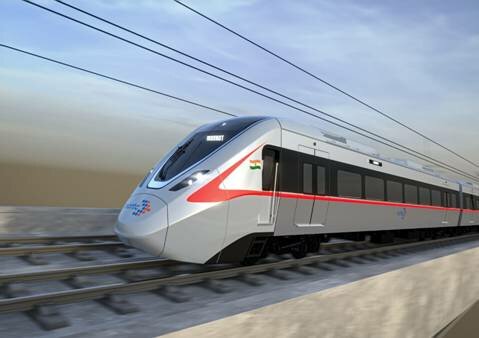First Look of India’s First RRTS Train Unveiled

First Look of India’s First RRTS Train Unveiled
New Delhi: The first look of India’s first Regional Rapid Transit System (RRTS) train was unveiled by the secretary of the Ministry of Housing and Urban Affairs and chairman, National Capital Region Transport Corporation (NCRTC) Durga Shanker Mishra on Friday. The NCRTC managing director Vinay Kumar Singh, all the members of Board of Directors of NCRTC and other senior officials of MoHUA were present on the occasion.
Speaking on the occasion, Mishra said that the environment friendly, energy efficient trains would improve the quality of life in and around NCR by accelerating economic growth, creating economic opportunities and at the same time reducing air pollution, carbon footprint, congestion, and accidents.
According to the MoHUA, the state-of-the-art RRTS rolling stock will be first of its kind in India with a design speed of 180 kmph. With radiating stainless-steel outer body, these aerodynamic RRTS trains will be lightweight and fully air-conditioned. Each car will have six automatic plug-in type wide doors, three on each side (Business Class will have four such doors, two on each side) for ease of access and exit. The RRTS trains will have transverse 2×2 seating with adequate legroom, optimized aisle width with grab handles and grab poles for a comfortable journey for standing passengers, overhead luggage rack, mobile/laptop charging sockets and on-board Wi-Fi among other commuter-centric features. New Delhi’s iconic Lotus Temple is an epitome of sustainability as its design allows flow of natural sources of light and air circulation. On the similar lines, RRTS rolling stock will have lighting and temperature control systems to enhance the passenger experience with less energy consumption. Equipped with modern amenities, the RRTS rolling stock will be a unique amalgamation of new-age technology and India’s rich heritage.
First Look of India’s First RRTS Train Unveiled
The NCRTC MD said, “The rolling stock of India’s first RRTS has been designed with a vision to fulfil the aspirations of the New India. The RRTS rolling stock will be energy-efficient with about 30% regeneration during braking. NCRTC has awarded the rolling stock work with an integrated long-term comprehensive maintenance by the manufacturer, thus leveraging the benefits of life cycle costing. I am confident that RRTS will prove to be transport backbone for the people of NCR and will define a new benchmark in the transport sector enabling the overall growth of the region”.
The prototype is scheduled to roll off the production line in 2022 and will be put into public use after extensive trials. NCRTC will procure 30 train sets of 6 cars each for operating regional rail services on the entire corridor and 10 train sets of 3 cars each for operating local transit services in Meerut. The entire rolling stock for Delhi-Ghaziabad-Meerut RRTS corridor will be manufactured at Bombardier’s Savli plant in Gujarat.
First Look of India’s First RRTS Train Unveiled
The Delhi-Ghaziabad-Meerut RRTS corridor is one of the three prioritised RRTS corridor being implemented in phase-1. The 82 km long Delhi–Ghaziabad–Meerut Corridor is the first RRTS corridor being implemented in India. The corridor will bring down the travel time between Delhi to Meerut by around 1/3rd. The commute time from Delhi to Meerut will be reduced to less than an hour from 3-4 hours by road at present. Civil construction work on about 50-km long section between Sahibabad and Shatabdi Nagar, Meerut is in full swing including the construction of four stations – Ghaziabad, Sahibabad, Guldhar and Duhai. The priority section of the corridor is targeted to be commissioned in 2023, while the entire corridor will be commissioned in 2025. The other two Phase-I RRTS corridors are Delhi-Gurugram-SNB and Delhi-Panipat. Pre-construction activities are in full swing for Delhi-Gurugram-SNB corridor and its DPR is under active consideration of the Government of India for sanction. The DPR of the Delhi to Panipat RRTS corridor is also under active consideration of the respective State Governments for approval.






